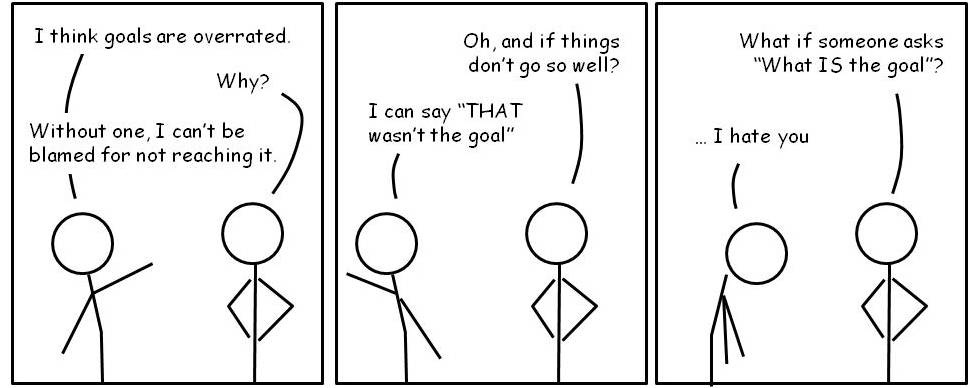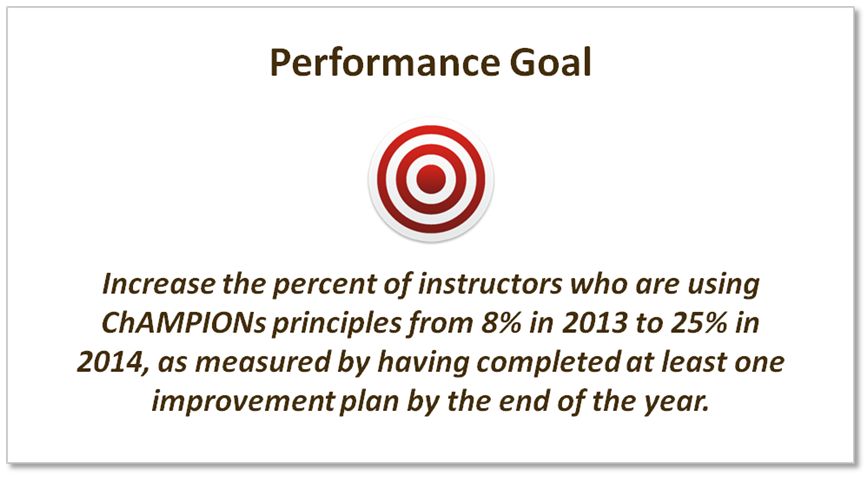In this part of our design challenge, we are going to look at performance goals for the ChAMPIONs project. If you need a refresher on our challenger or the project we are discussing, look at Design Challenge #1 – Part 1 of 4: Meet Our First Challenger.
The Value of a Performance Goal
There are a lot of good reasons for creating a performance goal; here are three:
- They help justify your project. Then, when you’re having trouble obtaining the resources you need, like time with a busy subject matter expert, you can point to your goal and say “I know you’re busy, but here’s why we’re doing this [pointing to your goal] and I need your help to get it done.”
- A performance goal keeps the project on track. It seems like every project has a moment (or twenty) where a manager or a subject matter expert says, “Hey, wouldn’t it be awesome if…” Sometimes that awesome idea really is awesome and fits nicely into the project. Other times, that awesome idea is out in left field. The performance goal is the measuring stick that determines what should be included in the course, and what should not.
- A performance goal can earn you some well deserved kudos. Admittedly, it can be hard to gather performance data, but if you can do it, you can reap some real rewards. For example, you roll out your course about the company’s software system and then obtain some data from IT on the number of support calls they’ve received about the system, and, hallelujah, they’ve dropped by 18%. You do some quick math on the back of an envelope and calculate that the ROI for your course is 160%. I’ll leave it to your imagination what good things you could do with this kind of hard data.
How to Create a Performance Goal
So, how do we create a good performance goal for our challenger? There’s no need to reinvent the wheel, if we want to make sure we have a good goal, we need to check off as many of the SMART criteria as possible.
- Specific
- Measurable
- Attainable
- Relevant
- Time-bound
SMART is widely used for setting goals; however, in elearning situations, the “R” deserves special discussion. To make your goal relevant, focus on skills or performance, not knowledge. The problem with knowledge goals is that even if the learner knows something, it doesn’t mean that they will DO what is needed. For example:
If the zoo felt that there are too many factors that could impact visitor safety that employees can’t control, we could also consider using a goal that is more directly influenced by training such as “Zoo staff implement all five safety guidelines on every tour”. I think either of these goals would be fine since they are DOing goals, not KNOWing goals.
Writing goals may sound easy, but in practice it can sometimes be a bit tricky. Let’s walk through how we came up with a goal for Design Challenge #1. Remember, we want to help college instructors teach more effectively by using a professional development program called ChAMPIONS. Our goal iterations are shown below.
Performance goal, version 1: “Ensure that 100% of students pass xyz course this semester”. (Note, “students” refers to the students that are taking courses at the community college. Those courses are taught by instructors that have hopefully been through the ChAMPIONs course.)
From what Dr. Kalish told us, we know that the ChAMPIONs program is very effective for those that have completed it, but the problem is that not enough instructors can take the training. Additionally, many factors may influence student pass rates which we can’t control. So, a more Relevant measure for this project would be increasing the number of instructors who are completing the course and using the ChAMPIONs principles in their teaching.
Performance goal, version 2: “Increase percent of instructors who are using ChAMPIONs principles from 8% in 2013 to 25% in 2014.”
This is a much better goal; however, “using ChAMPIONs principles” is vague and hard to measure. One more iteration will improve the Measurability of the goal.
Business goal, version 3: “Increase the percent of instructors who are using ChAMPIONs principles from 8% in 2013 to 25% in 2014, as measured by having instructors complete at least one improvement plan by the end of the year.”
The Performance Goal is the first step in the action mapping process, so we’ll place it at the center of our diagram.
In the next blog post, we’ll look at the skills and behaviors that the instructors need have to to achieve this goal.
Do you like this goal for the ChAMPIONS program? Any ideas to improve it? What goals are you working on or wrestling with?
DESIGN CHALLENGE
Read the Series
- Introducing the Elearning Design Challenge Series
- Part 1: Meet the First Challenger
- Part 2: Crafting a Goal
- Part 3: What Do You Want Learners to DO?
- Part 4: Create Learning Activities that Work




Rob, IMHO this is very well done.
Dr. K
Thanks Mia. Now we just need to create the elearning to realize the goal!
This is a good goal/objective because it is focused on the desired end result – aka the terminal result (the connection between the completion of improvement plans and those that are using Champion principles).
The only thing that might add to the value of the goal is to consider including something that tells the story as to why this intervention is necessary. It can be brief. Something like, “instructors need this so that they can become aware how to evaluate teaching outcomes that will allow the school to regain accreditation.”
As Rob pointed out, goals are something that we get asked about frequently (his #1 above). When we are asked, we should be able to explain the goal in a way that is understandable and memorable. This brief story element encapsulates the need and the problem(s) that exists that are motivating the need.
Great addition to the check list for writing goals (“Story+SMART”). Your comment reminds me that while goals help with project management by keeping us on track, they are equally important as motivators and influencers for stakeholders that aren’t as close to the project as we are.